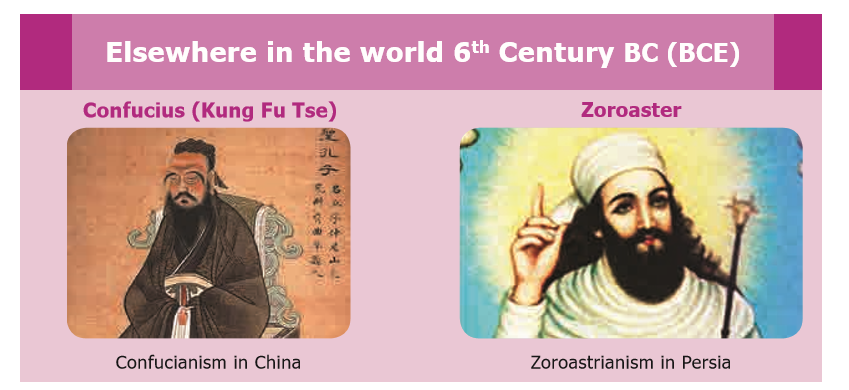Great Thinkers and New Faiths Notes 6th Social Science
Great Thinkers and New Faiths Notes 6th Social Science
6th Social Science Lesson 10 Notes in English
10. Great Thinkers and New Faiths
1. What is Shower of Stars?
As a land mark period is sixth century in the intellectual and spiritual development in India, historian Will Durant has rightly called it the “shower of stars”.
2. Literary Sources:
- Angas – Jain texts
- Tripitakas and Jatakas – Buddhist texts
3. Causes of Intellectual Awakening:
- The complex rituals and sacrifices advocated in the later Vedic period
- Expensive sacrificial ceremonies
- Superstitious beliefs and practices that confused the common man.
- Slavery, caste system, gender discrimination also contributed to the new awakening.
4. Which of the following is alternative for Sacrificial Rites?
Upanishads taught as alternative to sacrificial rites were too philosophical, which a layperson could not understand.
5. The word Jain derives from the Sanskrit word Jina, which means conquering self and the external world.
6. The belief that a person’s actions in this life determine the quality of his or her later part of the current life and the next incarnation.
7. Omniscience – It is the ability to know everything or be infinitely wise.
6th Social Book Back Questions
8. Moksha – Liberation from the cycle of birth and death.
9. Origin of Jainism:
Jainism is one of the world’s oldest living religions. Jainism grounds itself in 24 Tirthankaras.
10. Who are Tirthankara?
A ‘Tirthankara’, is the one who revealed religious truth at different times. The first Tirthankara was Rishabha and the last one was Mahavira. Jainism gained prominence under the aegis of Mahavira, during the sixth century BC (BCE).
11. Mahavira (The Great Hero)
Vardhamana, meaning ‘prosperous’, was a kshatriya prince. However, at the age of 30, he renounced his princely status to adopt an ascetic life. He undertook intense meditation.
12. When did he attained omniscience?
After twelve and a half years of rigorous penance, Vardhamana attained omniscience or supreme knowledge, known as Kevala.
13. Who were jains?
He became Jina meaning ‘one who conquered worldly pleasure and attachment’. His followers are called Jains.
14. What is Jainism?
Mahavira reviewed the ancient Sramanic traditions and came up with new doctrines. Therefore he is believed to be the real founder of Jainism.
15. Unique Teachings of Jainism
- Jainism denies God as the creator of Universe.
- Basic philosophy of Jainism is Ahimsa or ‘non –Violence’.
- Ultimate aim of Jainism is attaining moksha or ending the cycle of birth – death – rebirth.
- Jains reject the belief in Last judgement, where God, a supreme being, decides who goes to heaven or hell.
- Jainism advocates that the goodness or quality of one’s life is determined by one’s karma.
16. Three Jewels of Mahavira:
- Right Faith
- Right Knowledge
- Right action
17. Short History of Mahavira:
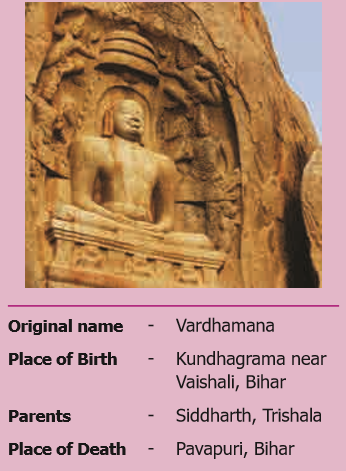
18. Jain Code of Conduct:
- Ahimsa – not to injure any living beings
- Satya – to speak truth
- Asteya – not to steal
- Aparigraha – not to own property
- Brahmacharya – Celibacy
19. Gautama Swami, a chief disciple of Mahavira, compiled the teachings of Mahavira, called Agama sidhantha .
20. Explain the Digambara Sect:
- Digambaras are orthodox and conservative followers.
- Monks of the digambara sect, do not wear any clothing and live naked.
- They are forbidden to have any kind of possessions.
- Digambaras believe that women cannot achieve nirvana or liberation directly.
21. Svetambara sect:
- The Svetambaras are considered progressive.
- Svetambaras believe that women are equally capable of achieving liberation as men.
22. Who were robes?
Monks of Svetambaras sect, wear white robes. They are permitted to have Rajoharana (broom with wollen threads), begging bowl and book.
23. Reason for the Spread of Jainism:
- Use of people’s language.
- Intelligible teachings.
- Support from rulers and traders.
- Perseverance of Jain monks.
24. What is samanam?
- In ancient Tamil literature, Jainism is referred to as Samanam.
- There is a Samanar Hill or Samanar Malai in Keelakuyilkudi village, 15 km away from Madurai.
- The images of Tirthankaras created by Jain monks are found in the hill. It is a protected monument of Archaeological Survey of India.
25. Where is Pandavar Padukkai?
In Arittapatti, a small village 25 km from Madurai, on one side of Kalinjamalai hill there are Jain caves called Pandavar Padukkai. Pandavar Padukkai is the bed of Jain saints.
26. How Manimegalai and Silapathikaram related to jainism?
There is a reference to Aravor Palli, place of living for Jain monks, in Manimegalai.According to Silapathikaram, when Kovalan and Kannagi were on their way to Madurai, Gownthiyadigal a female jain monk blessed the couple and accompanied them.
27. Various other Jain Places:
- Puhar, Uraiyur, Madurai, Vanchi (Karuvur), Kanchi all had Jain monasteries.
- Jina Kanchi – Thiruparthikundram, a village in Kanchipuram, has two ancient Jain temples. This village was once called Jina Kanchi.
28. Small History of Siddhartha:
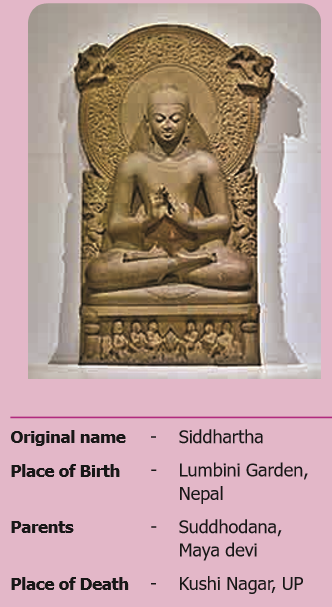
29. Early life of Gautama Buddha:
Gautama Buddha was the founder of Buddhism. His real name was Siddhartha. Like Mahavira, he was also a Kshatriya prince belonging to the ruling Sakya clan.
30. By whom Siddhartha was Raised?
When Siddhartha was only seven days old his mother died. So he was raised by his step mother Gautami.
31. When did Buddha saw sorrowful sights?
At the age of 29, Siddhartha saw four sorrowful sights.
32. Four Great Sights:
- An uncared old man in rags with his bent back.
- An sick man suffering from an incurable disease.
- A man’s corpse being carried to the burial ground by weeping relatives.
- An ascetic
33. When did Buddha realised himself?
Buddha, the Awakened or Enlightened One, realised that the human life was full of misery and unhappiness. So at the age of 29 he left his palace and became a hermit.
34. How many years he sacrificed?
He sacrificed six years of his life towards penance. Nonetheless deciding that selfmortification was not a path to salvation, Buddha sat under a Pipal tree and undertook a deep meditation near Gaya.
35. When did he attained enlightment?
On the 49th day he finally attained enlightenment. From that moment onwards, he was called Buddha or the Enlightened One. He was also known as Sakya Muni or Sage of Sakya clan.
36. What was Dharma Chakra Pravartana?
Buddha delivered his first sermon at Deer Park in Sarnath, near Benaras. This was called “Dharma Chakra Pravartana” or the Turning of the Wheel of Law.
37. Buddha’s Four Noble Truths:
- Life is full of sorrow and misery.
- Desire is the cause of misery.
- Sorrows and sufferings can be removed by giving up one’s desire.
- The desire can be overcome by following the right path (Noble eightfold path)
38. Eight Fold Path:
- Right view
- Right Thought
- Right Speech
- Right Action
- Right Livelihood
- Right Effort
- Right Knowledge
- Right Meditation
39. What is Dhamma?
Buddha’s teachings are referred to as dhamma.
40. What did Buddha accepted?
- Buddhism accepted the Theory of Karma – meaning that the quality of man’s life depends on his deed.
- Buddha neither accepted nor denied the existence of God, but believed in the laws of universe.
41. Teachings of Buddha:
- Buddha asserted that attaining nirvana is the ultimate aim of life.
- Buddha advocated ahimsa or nonviolence.
- Buddha had rejected the caste system.
42. What is Wheel of life?
The Wheel of life – represents the Buddhist view of the world.
43. What is Sangha?
Buddha laid foundation for a missionary organization called Sangha, meaning ‘association’ for the propagation of his faith.
44. Who were Bhikshus?
The members were called bhikshus (monks). They led a life of austerity.
45. Chaitya – A Buddhist shrine or a meditation hall.
46. Viharas – Monastries / living quarters for monks.
47. Stupas – Built over the remains of Buddha’s body, they are monuments of great artistic value
48. Causes for the Spread of Buddhism:
- Simplicity of the teachings of Buddha in local language appealed to people.
- Buddhism rejected elaborate religious customs whereas the practice of orthodox Vedic religion insisted on expensive rituals and sacrifices.
- Buddha’s emphasis was on observance of Dhamma.
49. What played important role to spread Buddhism?
- Buddhist Sanghas played an important role in spreading the messages of Buddha.Royal patronage under Ashoka, Kanishka and Harsha also helped the causes of Buddhism.
50. What were the centres of Education?
Viharas or the Buddhist monasteries became great centres of education.
51. Which chinese travelers studied in Nalanda?
Nalanda, where Hiuen Tsang, the Chinese pilgrim, studied for many years.
52. Frescoes (paintings):
Frescoes on the ceilings and walls of the Ajanta caves in Aurangabad, Maharashtra – depict the Jataka Tales.
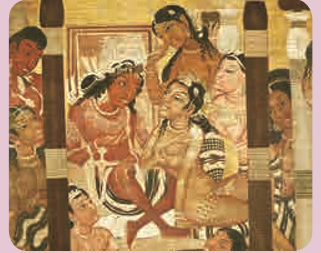
53. Middle path – It refers to neither indulging in extreme attachment to worldly pleasure nor committing severe penance.
54. Buddhist Sects:
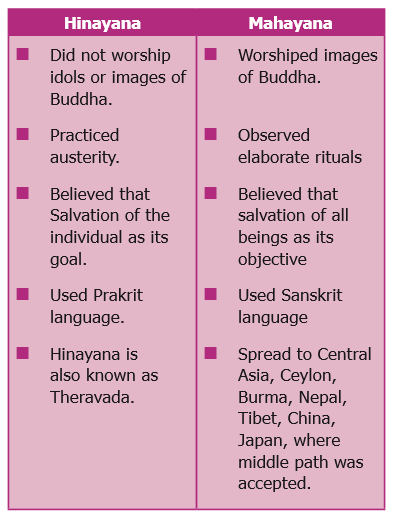
55. Buddhism and Jainism Similarities and Differences:
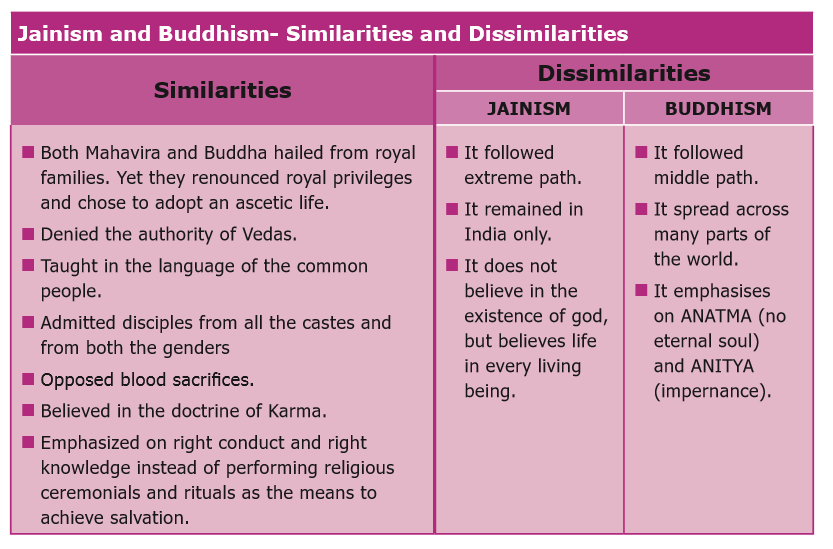
56. Four Buddhist council:
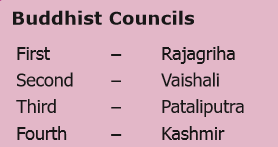
57. Influence of Buddhism in Tamilnadu
Buddhism spread to Tamil Nadu much later than Jainism. Manimekalai, one of the epics of the post-Sangam age is a Buddhist literature.
58. Various Buddhist Scholar:
- Kanchipuram was a famous Buddhist Centre, from where Dinnaga, the famous Buddhist logician, and Dharmapala, a great scholar of Nalanda University hailed.
- Hieun Tsang who visited Kanchipuram in the seventh century A.D(CE). noticed the presence of 100 feet stupa built by Ashoka there.
59. Various other Religion in world at the Same period:
